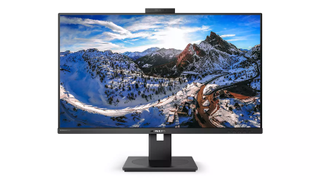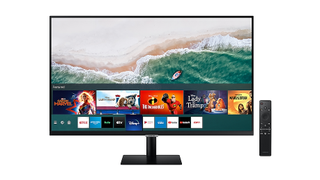If you're on the hunt for a 4K monitor then here you'll find two top-rated displays from T3's best 4K monitors guide that both offer a 4K resolution and a 32-inch screen (actually 31.5in for the Philips).
While they may look similar at first glance, they're actually quite different. Which one will be best for you will depend largely on what you need it for.
To build out your home office, the Phillips is undoubtedly the better choice thanks to its handy pop-up webcam and Windows Hello support. But if you're after something a bit more versatile that can double up as a smart TV then you're better off choosing the Samsung because it has Wi-Fi and comes loaded with some of the most popular streaming apps. And it even has a remote with Bixby voice support, SmartThings integration and Apple AirPlay 2.
But, the question is, which is best? Here in T3's Philips 329P1H vs Samsung M70A Smart Monitor comparison feature, we reveal all.
If you're planning on using this for gaming as well, then you could be better off checking out the best gaming monitors.

Philips 329P1H vs Samsung M70A Smart Monitor: Design
When it comes to design, there is very little to separate these two monitors. Both of these 32-inch, 4K displays have slim bezels and sit on square, centrally-mounted and compact feet. Both also have the option of attaching a 100x100mm VESA mount for wall mounting or fitting to a monitor arm.
The latter might be useful for owners of the Samsung Smart Monitor, as its own stand does not feature any side-to-side or height adjustment, which is somewhat unusual for a desktop monitor and means you are stuck with one height. In this aspect, the Samsung’s design is closer to that of a television than a desktop monitor. Helpfully, the screen can be tilted vertically between -2 and +22 degrees.
Meanwhile, the Philips offers a more conventional design, with height adjustment of 180mm, pivot of plus or minus 90 degrees, swivel of 180 degrees and a tilt of between -5 and +25 degrees, helping you find the perfect position to work comfortably.
Another key difference – and another example of how the Philips is more suited to a work environment than the entertainment-friendly Samsung – is the pop-up webcam of the Philips. This sits centrally at the top of the screen, ready for your next Zoom call, and also works with Windows Hello, letting you log into your Windows 10 machine with face recognition.


Philips 329P1H vs Samsung M70A Smart Monitor: Hardware and connections
Turn the Philips around and you will find a DisplayPort 1.4 connection, along with a pair of HDMI 2.0 ports and a single USB-C socket. These are all compatible with HDCP 2.2.
There is also an audio out connection for plugging in headphones or external speakers with a 3.5mm audio cable, and an RJ45 Ethernet connection. The USB-C port can be used to send video and audio from a connected laptop, but also power the laptop itself.
The Philips also has four USB-A ports, one of which is equipped with fast charging to quickly top up the battery of devices like smartphones and tablets.
Sound is handled by a pair of 5W speakers. Desktop monitors aren’t usually known for their sound quality, so if buyers are wanting to use this screen for entertainment too they might want to invest in a speaker system they can attach to either their computer or the monitor itself.
The aforementioned pop-up webcam has a 2.0-megapixel resolution and is capable of recording in Full HD 1080p quality. It has an integrated microphone and an LED light to let you know when it is recording and being used with Windows Hello.
As for the Samsung M70A Smart Monitor, there are a pair of HDMI 2.0 connections, with one supporting ARC. Usually found on televisions and sound bars, an ARC HDMI connection stands for audio return channel and lets you send audio from a screen back to a sound bar or amplifier. That way, you can plug the monitor into a sound bar, and the audio of whatever else you attach to the screen, such as a computer via USB-C, will send its audio to the sound bar instead of to the monitor’s own speakers.
Speaking of USB-C, the Samsung screen has a 65W connection for plugging in a computer or laptop with the latter being charged at the same time. There are also two USB-A 2.0 ports and, in a nod to the monitor’s smart credentials, Bluetooth and Wi-Fi. On a related note, the Samsung comes with a remote for controlling its smart features; anyone who has used a Samsung TV or sound bar in the last few years will immediately recognise this remote.

Philips 329P1H vs Samsung M70A Smart Monitor: Specifications
There is also Samsung’s DeX system, for wirelessly connecting a Galaxy smartphone and using that as a simple computer, and there is Apple AirPlay 2 for wirelessly connecting to a MacBook and having the Samsung act as a second monitor.
Both of these monitors have a 16:9 aspect ratio; the Samsung display is 32 inches and the Philips is 31.5 inches. They both have 4K resolutions of 3580 x 2160 at 60Hz. The Philips has a contrast ratio of 1000:1, while the Samsung is rated at 3000:1. Brightness for the Samsung is 250 cd/㎡, but the Philips manages 350 cd/㎡. The Philips also wins when it comes to response time, which is 4ms compared to 8ms for the Samsung.
All of this means the two monitors have a lot of technical specifications in common, with only the Samsung’s improved contrast ratio and the Philips’s quicker response time setting the two apart. This means the former should be better suited to accurate image and video editing, while the latter could prove better for gaming. That said, for general computer work and occasional entertainment there is little to split them.
By far the biggest difference between these two monitors is how the Samsung also partially doubles as a smart television. It can’t be connected to an aerial, but with its Wi-Fi connection and Tizen operating system, it works very much like Samsung’s smart TVs, with its access to streaming apps like Netflix and iPlayer for when you’ve done enough work for the day.
With many of us working from home at the moment, a computer monitor that doubles as a smart TV could be hugely valuable to some users, and especially those who have a small desk in their bedroom and want a monitor that doubles as a TV to watch from the bed. The Samsung also has the Bixby voice assistant, accessed via a microphone in the remote, and integration with SmartThings, the company’s smart home system.

Philips 329P1H vs Samsung M70A Smart Monitor: Price and verdict
The Philips 329P1H is priced at £519. The company also offers the 326P1H, which is the same design and also measures 31.5 inches, but has a QHD resolution (2560 x 1440) and is priced at £399. The Samsung is a fair bit cheaper, with a price of £399, and the company also offers a Full HD version priced at £279 for a 32-inch model and £229 for 27 inches. Be sure to take a look at the widgets on this page though because you might be able to find some good deals on both monitors.
When looking at the 32-inch, 4K models, deciding between these two monitors comes down to what you want from your screen.
If this is being bought for a dedicated workspace in your home or office, then the Philips with its integrated webcam and faster response rate will appeal. But if you want a computer monitor that can also double as a smart television, perhaps to be used in a make-shift home office in a bedroom, then the Samsung and its Tizen operating system is a great option.
- These are the best office chairs for comfort



